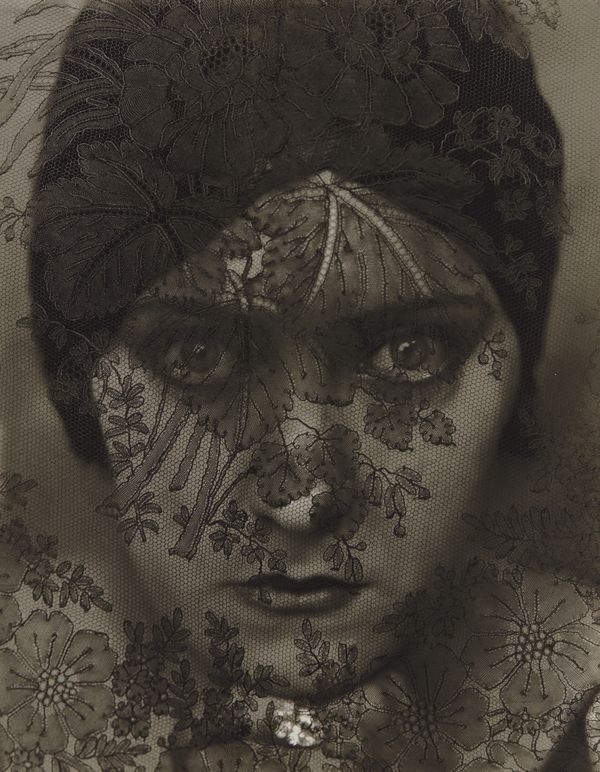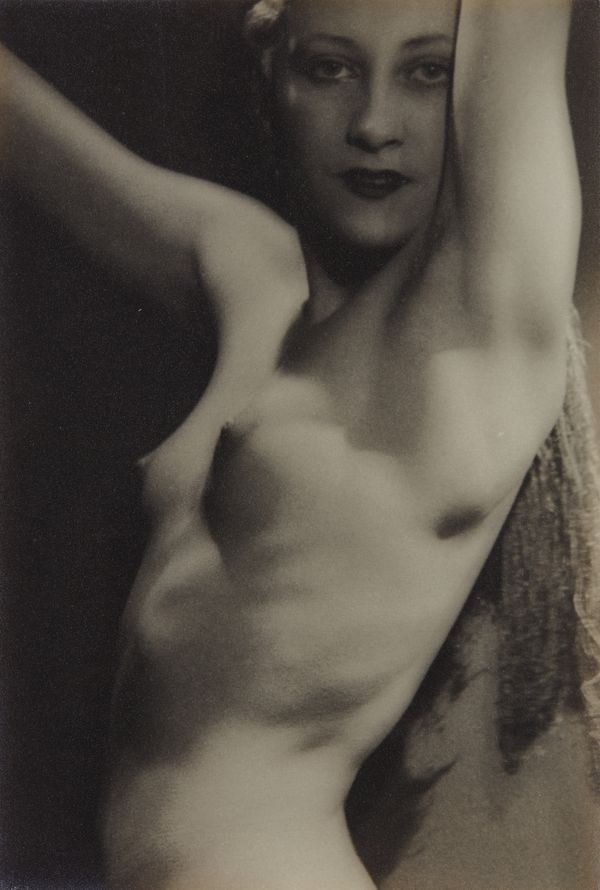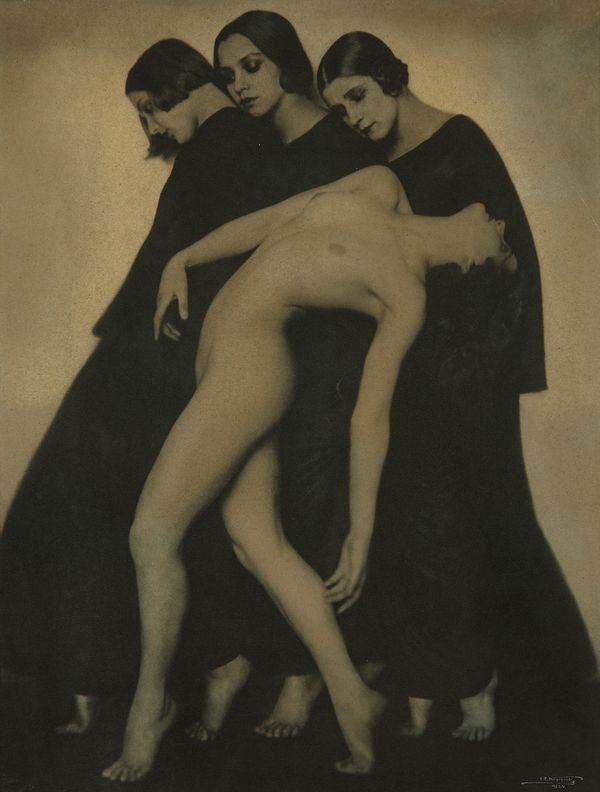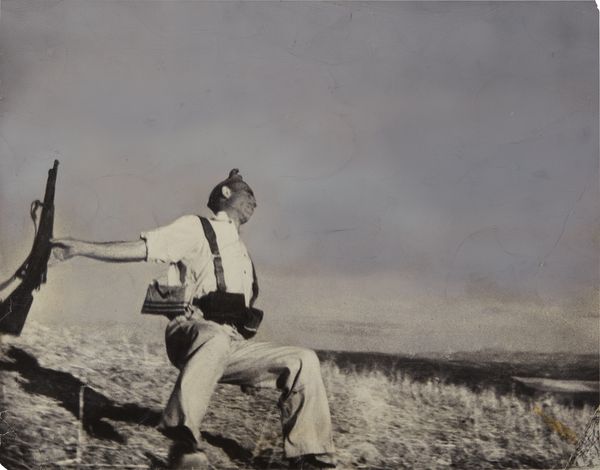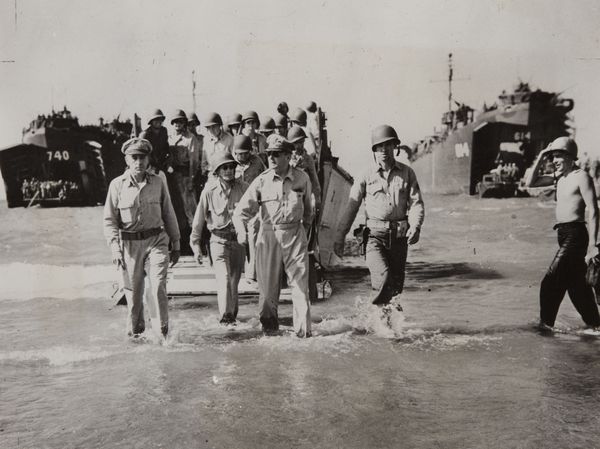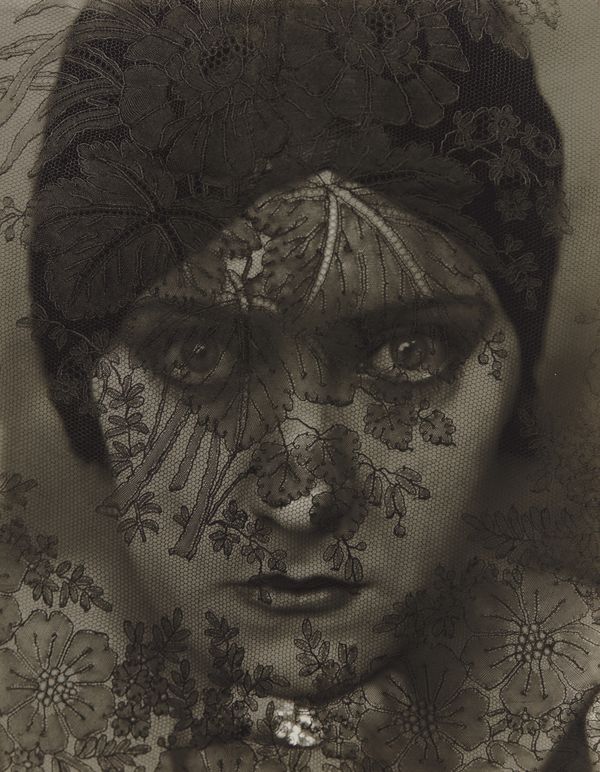Edward Steichen Gloria Swanson, New York, 1924
This season in New York, we are honored to present The Enduring Image: Photographs from the Dr. Saul Unter Collection. The photographs in this collection illustrate the endurance of the human spirit. From his first purchases in the 1990s, Dr. Unter focused upon images documenting resilience in the face of adversity and the beauty that emerges out of struggle. It is a collection marked by curiosity and inclusiveness. Dr. Unter notes, "I found that great photography captures a moment in time that can never be duplicated. Hence I started my collection."
His collection — which comprises lots 95–123 in our Photographs sale on 9 April — encompasses the full range of the human experience. This is exemplified from the heroism of Carl Mydans' photograph of General MacArthur retaking the Philippines and Joe Rosenthal's Flag Raising on Iwo Jima; to the pathos of Arthur Rothstein's Dust Storm; to the mesmerizing elegance of Edward Steichen's Gloria Swanson and Man Ray's Nude. Photojournalism rubs shoulders with studio photography, and the line between documentary and art is satisfyingly blurred.
The act of photographing is, for Dr. Unter, an expression of the human will to endure. In Robert Capa's icon, Death of a Loyalist Soldier, the photographer himself becomes a participant, determined that this soldier lives on to tell the story of the fight against fascism. Andreas Feininger's The Photojournalist is symbolic of this necessity to see and to record. Each photograph in the collection possesses its own unique and infinite visual impact.
While Dr. Unter collected some of the most resonant images of the 20th century, he also acquired photographs that, as objects, tell their own story. Koppitz's incomparably graceful Bewegungsstudie bears its impressive exhibition history on its verso. Other prints, like Death of a Loyalist Soldier, wear documentation of their long and illustrious publication history, which continues today. The images from this collection, which include the renowned and historic highlights below, are ones that have truly endured in our shared visual culture.
Man Ray Nude, 1927
This nude study was originally in the collection of art critic, curator and collector James Thrall Soby. Soby was the publisher of Man Ray's first monograph, Photographs by Man Ray 1920 Paris 1934, and the organizer of his 1934 exhibition at the Wadsworth Atheneum, the photographer's first solo showing at an American museum. The photograph offered here was part of Soby's historic gift of over 100 Man Ray photographs to The Museum of Modern Art in 1940, which included many of the images used in, or considered for, Man Ray's seminal monograph.
By the 1930s, nudes comprised a significant portion of Man Ray's oeuvre, and an entire passage of Photographs by Man Ray 1920 Paris 1934 is devoted to the female form. The elegant nude offered here is at once representational and dreamlike. As in the best of Man Ray's photographs, conventional artistic subject matter is raised to the level of Surrealism and is reflective of the artist's distinctive vision. Through Man Ray's deft use of lighting and his mastery of darkroom technique, he has created in this image a nude whose form seems poised between human flesh and sculpted stone.
Like his contemporary, László Moholy-Nagy, Man Ray was a tireless experimenter in a variety of media. Both fully exploited the flexibility of photography to achieve new types of images. In his essay L'Age de la Lumière, Man Ray wrote that a disregard for a medium's conventions was necessary to be truly creative. He wrote that when a photographer, "working directly with light and chemistry, so deforms his subject as almost to hide the identity of the original, and creates new form, the ensuing violation of the medium employed is the most perfect assurance of the author's convictions. A certain amount of contempt for the material employed to express an idea is indispensable to the purest realization of this idea."
L'Age de la Lumière was originally published in the surrealist journal Minotaure in 1933, which also reproduced a multiple-exposure variant of the image offered here.
Rudolf Koppitz Bewegungsstudie (Movement Study), 1924
This multiple-gum print of Rudolf Koppitz's masterpiece, Bewegungsstudie, is remarkable for its large size, masterful print quality, extensive exhibition history, and direct provenance. The array of printed labels affixed to the reverse of the print documents its inclusion in no fewer than nine exhibitions in Europe and America between 1928 and 1932. Koppitz gave this print to his assistant Alfred Ernst, an accomplished photographer in his own right. All of these qualities demonstrate that Koppitz regarded this print highly and that it met his own exacting standards.
Born in Czechoslovakia, Koppitz studied, worked and taught in Vienna for most of his career. His development as a photographic artist paralleled his mastery of the photographic processes of his day. The print offered here, which Koppitz describes as a "combination gum" print shows the effects he was capable of generating in the printing process. More than other prints of this image, the example offered here delivers a remarkable range of detail and tonal subtlety. The faces of the dancers are rendered with great clarity, as are their delicately arched feet, which are frequently obscured in other prints. The dancers' black robes, which at first seem absolutely black, show detail in their folds upon prolonged examination, giving them a sense of three-dimensionality and movement. In all respects, it is a bravura print. While the gum and pigment processes are generally regarded as tools for the Pictorialist photographer and were typically used to create atmospheric, Impressionistic prints, Koppitz used the process here to create a highly detailed and richly-toned photograph that includes elements of Modernism, Pictorialism and Surrealism, while also relating to the Viennese Secession and the Wienner Werkstätte movements in its stylized grace and perfection of craft.
Koppitz was perhaps the most accomplished Austrian photographer of his day, and he was an active exhibitor of his work. He took advantage of the international network of camera clubs and salons to ensure that his work was widely seen. The exhibition labels on the print's verso are a testament to this ambition. Today, Koppitz's work is appreciated but difficult to categorize. Elements of his life and creative development parallel that of his contemporaries. Like Edward Steichen, he served as an aerial combat photographer in World War I. With Heinrich Kühn, he shared a belief in the beauty and redemptive value of nature. Like Pierre Dubreuil, he achieved fame in his own day as a creator of entirely novel imagery that had no direct corollary in the photography of the time. He shared with these photographers a deep understanding of photographic technique and utilized a repertoire of complex print processes to execute his photographic ideas. Despite these resemblances, Koppitz's work and aesthetic are distinctly his own.
During the artist's lifetime, Bewegungsstudie became his most famous image, and his studio produced gelatin silver prints and photogravures of it in a variety of formats. While the image retains its graphic impact across these media, these smaller prints do not convey the detail or subtlety of the combination gum print offered here, nor do they possess the impact imparted by its large size. Stylized, graceful and mysterious, Bewegungsstudie has remained Koppitz's best-known work. This masterful, large-format multiple-gum print represents the ideal presentation of this timeless image.
Robert Capa Death of a Loyalist Soldier, 1936
Robert Capa's Death of a Loyalist Soldier, the photographer's most famous image and an instantly recognizable classic, brought a new immediacy to photojournalism. Capa's photograph, which captures the last second of a soldier's life with graphic intensity, is both shocking and riveting and conveys the visceral experience of combat. Death of a Loyalist Soldier caused a sensation upon its initial appearance and has remained one of the most unforgettable images within our visual culture.
Capa took this photograph in Spain in September 1936 while on assignment for Vu magazine. It was first published in Vu on September 23, on a page spread of Capa's photographs of the Civil War in Spain. The conflict in Spain was of intense interest to the story-conscious Capa. The noble fight of Spanish citizens against the fascist forces led by General Francisco Franco, who was funded and armed by Hitler and Mussolini, resonated with him deeply. Armed with his Leica camera, as well as his ability to get into the heat of the action, Capa plunged into Spain looking for great images.
Death of a Loyalist Soldier reached a much larger audience when it was published in LIFE magazine in July 1937. Its appearance there not only propelled Capa into the top ranks of photojournalism, it also signaled a shift in American opinion about the conflict. In LIFE, Capa's photograph runs the width of the page. The article beneath it notes: "On July 17 the Spanish Civil War will be one year old...When the war started, most U.S. citizens looked on the Loyalists as a half-crazy, irresponsible, murderous scum that had turned on its honorable betters. A year of war has taught the U.S. more of Spain...The reason for the civil war was simply that the people of Spain had fired their bosses for flagrant incompetence and the bosses had refused to be fired." This is followed by six pages of photographs and text devoted to the war, with contributions by Ernest Hemingway, addressing the seriousness of the conflict. This coverage signaled that the situation in Spain was now being taken seriously in the mainstream media. Capa's photograph was the lead image of the story, and its graphic depiction of the war brought the conflict home to Americans. It is, as Capa authority Robert Whelan observes, "almost universally acknowledged as one of the greatest war photographs ever made." Whelan's in-depth account of the taking of this picture, and the discussion about the locale and circumstances in which it was made, appears in his book This is War! Robert Capa at Work.
The print offered here comes originally from the Time Inc. Picture Collection. As the overlapping strata of usage information on its reverse makes clear, Death of a Loyalist Soldier has a publication history that is nearly too long to document. It appeared repeatedly within the pages of LIFE and Time magazines in the decades following its making and was illustrated in countless anthologies of the magazines' best images. In many cases, this was the print used for reproduction. The continued use of this photograph shows that, long after its newsworthiness had passed, its impact remained undiminished, and Death of a Loyalist Soldier remains one of the most indelible images of the 20th century.
Carl Mydans Gen. Douglas MacArthur with Gen. Richard Sutherland and Col. Lloyd Lehrbas walks through the surf to the beach at Lingayen, Luzon, the Philippines, 1945
Carl Mydans' most famous photograph captures General Douglas MacArthur striding ashore in the Lingayen Gulf at Luzon, the Philippines, as American forces retook the area from the Japanese in January 1945. When Japanese Imperial forces had taken control of strategically-important Luzon in 1941, forcing an American withdrawal, MacArthur had famously proclaimed, "I shall return." Mydans' photograph captures the very moment of MacArthur's triumphant fulfillment of that promise.
Mydans' image was reproduced in LIFE magazine's 19 February 1945 issue as part of a feature, written by Mydans himself, documenting in words and pictures the liberation of the Philippines. His courageous coverage of both the Pacific and European theaters had earned him General MacArthur's respect. In Photojournalist, Mydans described the flinty general as the "most brilliant military mind I had ever known," and came to appreciate his ability to stage-manage dramatic events, such as the landing at Luzon, for the camera. Mydans wrote, "No one I have ever known in public life had a better understanding of the drama and power of photography."
Edward Steichen Gloria Swanson, New York, 1924
Edward Steichen's iconic image of Gloria Swanson is one of the most celebrated portraits of the 20th Century and remains captivating nearly a century after its making. The photograph was the result of a 1924 sitting for Vogue magazine that Steichen recounted in his autobiography, A Life in Photography: "The day I made the picture, Gloria Swanson and I had a long session, with many changes of costume and different lighting effects. At the end of the session, I took a piece of black lace veil and hung it in front of her face. She recognized the idea at once. Her eyes dilated, and her look was that of a leopardess lurking behind leafy shrubbery, watching her prey. You don't have to explain things to a dynamic and intelligent personality like Miss Swanson. Her mind works swiftly and intuitively."
The portrait was a collaboration between two highly accomplished professionals. In many ways, photographer and subject were kindred souls; both possessed an extraordinary ambition to excel in their respective fields, and both maintained successful high-profile careers throughout their long lives. Swanson was one of few actresses to make the transition from the silent-film era to sound, and thence to theatre and television. Steichen was that rare photographer who produced masterful images as a Pictorialist, a Modernist, an aerial and combat photographer and as a photographer of fashion and celebrity. Steichen and Swanson's interaction in the studio on that day in 1924 illustrates the intense devotion of each to their own objective: Swanson to perpetuate her allure, and Steichen to capture his subject at her most alluring.
Vanity Fair published this image in its February 1928 issue to coincide with the release of the film Sadie Thompson, starring and produced by Swanson, which had generated a fair amount of notoriety for its depiction of a jazz-age fallen woman attempting to find redemption on a tropical island. Swanson received an Academy Award nomination for the role, and Steichen's portrait became the definitive image of the star.
Few photographers have had as long, rich and varied a career as Edward Steichen, characterized throughout by an extraordinary intensity of vision and a devotion to the ever-changing craft of photography. Portraits were a constant throughout his career, and he seemed to work best when presented with a subject willing to actively engage with the process. His early studies of Rodin, Eleonora Duse and J. P. Morgan reveal his skill at working with charismatic, sometimes volatile, personalities. Steichen's images of Isadora Duncan and members of her dance troupe upon the Acropolis introduced a performative element to his images. His remarkable talent for photographing people is most apparent in the work he executed for Condé Nast beginning in the early 1920s, of which Gloria Swanson is a prime example. Photography historian Beaumont Newhall succinctly summed up Steichen's accomplishments during this phase of his career, as explained in The History of Photography: "These photographs are brilliant and forceful; they form a pictorial biography of the men of letters, actors, artists, statesmen of the 1920s and 1930s, doing for that generation what Nadar did for the mid-nineteenth century intellectual world of Paris." Early prints of this image appear infrequently on the market. In the past 25 years, only five other early prints have appeared at auction.
Browse more works from 'The Enduring Image: Photographs from the Dr. Saul Unter Collection', on view at Phillips New York on 450 Park Avenue from 31 March – 8 April prior to the auction at 10am EST on 9 April.
